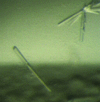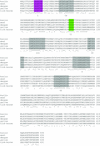issue contents
September 2006 issue

Cover illustration: The SH3 domain of human osteoclast-stimulating factor at atomic resolution (p. 844).
protein structure communications
Open  access
access
 access
accessThe structure of recombinant T. brucei UDP-galactose-4′-epimerase cocrystallized with NAD+ and the substrate analogue UDP-4-deoxy-4-fluoro-α-D-galactose has been determined at medium resolution. Comparisons with structures of human and E. coli UDP-galactose-4′-epimerase–ligand complexes reveal that the hexose moieties are able to adopt different orientations in the active site.
PDB reference: UDP-galactose-4′-epimerase complex, 2cnb, r2cnbsf
The X-ray crystallographic analysis of anti-FLAG M2 Fab is reported and the implications of the structure on FLAG epitope binding are described as a first step in the development of a tool for the structural and biophysical study of membrane proteins.
PDB reference: anti-FLAG M2 Fab domain, 2g60, r2g60sf
Mutation of Tyr94 of E. coli thymidylate synthase to phenylalanine leads to a protein with kcat reduced by a factor of 400. The Y94F structure is essentially identical to the wild-type structure, which is consistent with a catalytic role for the phenolic OH.
The crystal structure of the SH3 domain of human osteoclast-stimulating factor has been determined and refined to the ultrahigh resolution of 1.07 Å. The structure at atomic resolution provides an accurate framework for structure-based design of its inhibitors.
PDB reference: osteoclast-stimulating factor, 1zlm, r1zlmsf
Open  access
access
 access
accessThe structure of an uncomplexed form of α-amylase from B. halmapalus is compared with a form in which maltose, glucose and a nonasaccharide derived from acarbose and maltose are bound.
The crystal structure of the stand-alone RAM domain from T. thermophilus HB8 has been determined at 2.4 Å resolution. The structure revealed that five dimers are arranged to form a ring.
PDB reference: TTHA0845, 2djw, r2djwsf
crystallization communications
Open  access
access
 access
accessA construct consisting of residues 10–310 of mature BipD, a component of the B. pseudomallei type III secretion system, has been crystallized. Native BipD crystals and SeMet and K2PtCl4 derivative crystals have undergone preliminary crystallographic analysis.
Open  access
access
 access
accessIpaD, the putative needle-tip protein of the S. flexneri type III secretion system, has been crystallized in a variety of crystal forms using in-drop proteolysis. Native and selenomethionine-labelled data collection and preliminary analyses are reported.
A 24 kDa protein was purified from the seeds of L. sativus by ammonium sulfate fractionation and ion-exchange chromatography. Crystals were obtained by the hanging-drop vapour-diffusion method.
The CRP/FNR family transcription factor from M. tuberculosis H37Rv has been crystallized in space group P212121 in the absence of cAMP. The crystals show the presence of a dimeric molecule in the asymmetric unit.
The C-terminal 440 amino acids of the NS3 protein from Kunjin virus (Flaviviridae) code for a helicase. The protein has been overexpressed and crystallized. Characterization of the isolated monoclinic crystal form and diffraction data (at 3.0 Å resolution) are presented, together with a preliminary molecular-replacement solution.
Crystallization of a membrane-associated glucuronosyltransferase.
Crystals of S. islandicus filamentous virus (SIFV) protein 14 have been grown at 293 K. Crystals belong to space group P6222 or P6422 and diffract to a resolution of 2.95 Å.
PhzM, an S-adenosylmethionine-dependent methyltransferase enzyme that catalyzes a reaction involved in the biosynthesis of pyocyanin in P. aeruginosa, was cloned, overexpressed and crystallized. Data collection from native and selenomethionine-labelled crystals is reported.
Two S. agalactiae proteins, the inorganic pyrophosphatase and the serine/threonine phosphatase, were crystallized and diffraction data were collected and processed from these crystals. The data from the two protein crystals extended to 2.80 and 2.65 Å, respectively.
The periplasmic stress protein RseB from E. coli was cloned, expressed and crystallized. Crystallographic data are presented and structure solution using the multiple isomorphous replacement approach (MIR) is in progress.
Pentaketide chromone synthase from A. arborescens has been overexpressed in E. coli, purified and crystallized. Diffraction data have been collected to 1.6 Å.
Crystallization of and preliminary crystallographic studies on an active-site mutant of pro-Tk-subtilisin from the hyperthermophilic archaeon T. kodakaraensis were performed.
The C-terminal catalytic domain of P. multocida toxin, which is the virulence factor of the organism in P. multocida, has been expressed, purified and subsequently crystallized using the sitting-drop vapour-diffusion technique.
The SecA ATPase from T. thermophilus was cloned, expressed, purified and crystallized. Complete diffraction data sets were collected for two crystal forms at 2.8 and 3.5 Å resolution, respectively. Determination of the structure is now in progress.
The peptidyl-tRNA hydrolase from M. tuberculosis has been crystallized in three closely related forms, two orthorhombic and one monoclinic, and X-ray diffraction data have been collected from them.
The crystallization of B. cereus chitinase is reported.
Glutathionylated glutaredoxin Grx1p from yeast was crystallized, along with a yellow fluorescent protein–glutaredoxin fusion protein.
In this study, the catalytic domain of rat protein tyrosine phosphatase η was produced in Escherichia coli in soluble form and purified to homogeneity. Crystals were obtained by the hanging-drop vapour-diffusion method.
Human synaptotagmin C2A-C2B has been expressed as a glutathione-S-transferase fusion protein in Escherichia coli. The purification, crystallization and preliminary X-ray analysis of this protein are reported here.
Glucose-1-phosphate uridylyltransferase (UgpG) from S. elodea ATCC 31461 has been expressed, purified and crystallized. Seven crystal forms were obtained and characterized to a maximum resolution of 2.65 Å.
The phosphofructokinase-2 enzyme from E. coli was crystallized in its tetrameric inhibited form. This is the only member of the ribokinase family known to suffer a transition from dimer to tetramer in response to the allosteric binding of MgATP.
Open  access
access
 access
accessCrystals of the C-terminal 10 kDa lid subdomain from the C. elegans chaperone Hsp70 have been obtained that diffract X-rays to ∼3.5 Å and belong to space group I212121. Analysis of X-ray data and initial heavy-atom phasing reveals 24 monomers in the asymmetric unit related by 432 non-crystallographic symmetry.


 journal menu
journal menu







































![[publBio]](http://journals.iucr.org/logos/publbio.gif)





